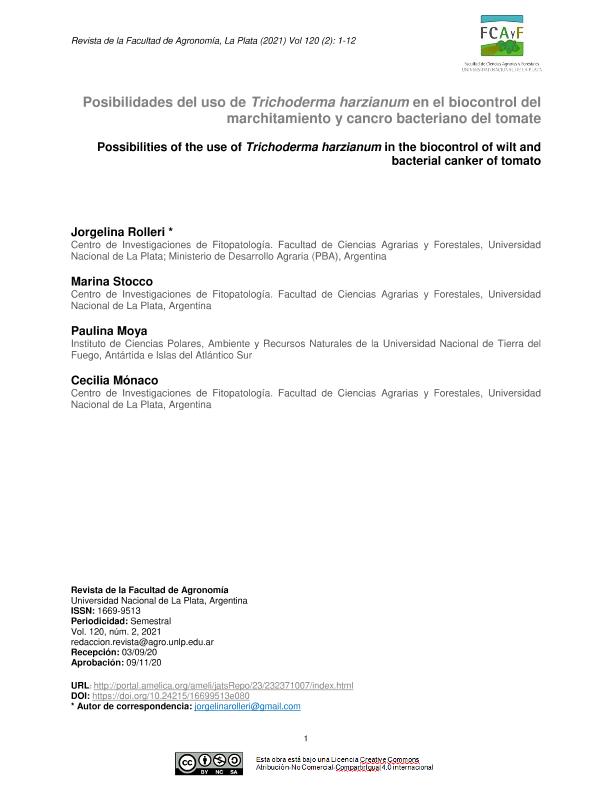Mostrar el registro sencillo del ítem
dc.contributor.author
Rolleri, Jorgelina

dc.contributor.author
Stocco, Marina Celeste

dc.contributor.author
Moya, Paulina

dc.contributor.author
Monaco, Cecilia Ines

dc.date.available
2022-05-17T17:28:18Z
dc.date.issued
2021-02
dc.identifier.citation
Rolleri, Jorgelina; Stocco, Marina Celeste; Moya, Paulina; Monaco, Cecilia Ines; Posibilidades del uso de Trichoderma harzianum en el biocontrol del marchitamiento y cancro bacteriano del tomate; Universidad Nacional de La Plata. Facultad de Ciencias Agrarias y Forestales; Revista Facultad de Agronomía; 120; 2; 2-2021; 1-12
dc.identifier.issn
1669-9513
dc.identifier.uri
http://hdl.handle.net/11336/157773
dc.description.abstract
El presente trabajo consistió en evaluar la posibilidad del uso de dos cepas de Trichoderma harzianum (Th118 y Th5cc) sobre la manifestación del marchitamiento y cancro bacteriano del tomate en plantas de tomate platense cultivadas en invernáculo. Ambas cepas se aplicaron al sustrato de la plantinera en forma sólida (S) y líquida (L) en el momento de la siembra. Clavibacter michiganensis subsp. michiganensis se inoculó en el momento del desbrote mediante una pequeña incisión en el tallo principal entre la quinta y sexta hoja El ensayo se repitió durante dos años consecutivos. Para cada tratamiento se evaluaron los componentes del rendimiento (peso y número de frutos) y número de hojas afectadas. Si bien no se encontraron diferencias significativas entre tratamientos durante los dos años, el tratamiento Th118L es el que presentó menor cantidad de hojas afectadas y valores promedio más altos de peso de frutos. De acuerdo a los resultados obtenidos, se puede afirmar que la cepa de Trichoderma harzianum Th 118 aplicada como riego a los plantines en el momento de la siembra, podría ser incorporada como una buena alternativa dentro de un plan de manejo integrado de enfermedades en el cultivo de tomate platense.
dc.description.abstract
The objective of this work was to evaluate the possibility of using two strains of Trichoderma harzianum (Th118 and Th5cc) against bacterial wilt and canker symptoms in tomato plants grown under greenhouse conditions. Both strains were applied on the substrate of the tomato seedling in solid (S) and liquid (L) form at sowing. Clavibacter michiganensis subsp. michiganensis was inoculated at the time of budding through a small incision in the main stem between the fifth and sixth leaves. The trail was repeated for two consecutive years. For each treatment, the yield components (number and weight of fruits) and number of affected leaves were evaluated. Although no significant differences were found between treatments during the two years, the Th118 L treatment was the only that presented the least amount of affected leaves and higher average values of fruit weight. According to results obtained, it can be stated that the Trichoderma harzianum Th118 strain applied as irrigation to the seedlings at the time of sowing could be incorporated as a good alternative within an integrated disease management plan in the tomato crops.
dc.format
application/pdf
dc.language.iso
spa
dc.publisher
Universidad Nacional de La Plata. Facultad de Ciencias Agrarias y Forestales
dc.rights
info:eu-repo/semantics/openAccess
dc.rights.uri
https://creativecommons.org/licenses/by-nc-sa/2.5/ar/
dc.subject
BIOCONTROL
dc.subject
CLAVIBACTER MICHIGANENSIS SUBSP. MICHIGANENSIS
dc.subject
TOMATE PLATENSE
dc.subject
ANTAGONISTAS
dc.subject
CULTIVO EN INVERNÁCULO
dc.subject.classification
Agronomía, reproducción y protección de plantas

dc.subject.classification
Agricultura, Silvicultura y Pesca

dc.subject.classification
CIENCIAS AGRÍCOLAS

dc.title
Posibilidades del uso de Trichoderma harzianum en el biocontrol del marchitamiento y cancro bacteriano del tomate
dc.title
Possibilities of the use of Trichoderma harzianum in the biocontrol of wilt and bacterial canker of tomato
dc.type
info:eu-repo/semantics/article
dc.type
info:ar-repo/semantics/artículo
dc.type
info:eu-repo/semantics/publishedVersion
dc.date.updated
2022-04-26T20:24:15Z
dc.journal.volume
120
dc.journal.number
2
dc.journal.pagination
1-12
dc.journal.pais
Argentina

dc.journal.ciudad
La Plata
dc.description.fil
Fil: Rolleri, Jorgelina. Universidad Nacional de La Plata. Facultad de Ciencias Agrarias y Forestales. Departamento de Ciencias Biológicas. Centro de Investigaciones de Fitopatología. Provincia de Buenos Aires. Gobernación. Comisión de Investigaciones Científicas. Centro de Investigaciones de Fitopatología; Argentina
dc.description.fil
Fil: Stocco, Marina Celeste. Universidad Nacional de La Plata. Facultad de Ciencias Agrarias y Forestales. Departamento de Ciencias Biológicas. Centro de Investigaciones de Fitopatología. Provincia de Buenos Aires. Gobernación. Comisión de Investigaciones Científicas. Centro de Investigaciones de Fitopatología; Argentina. Consejo Nacional de Investigaciones Científicas y Técnicas. Centro Científico Tecnológico Conicet - La Plata; Argentina
dc.description.fil
Fil: Moya, Paulina. Universidad Nacional de Tierra del Fuego. Instituto de Ciencias Polares, Recursos Naturales y Ambiente; Argentina. Consejo Nacional de Investigaciones Científicas y Técnicas; Argentina
dc.description.fil
Fil: Monaco, Cecilia Ines. Universidad Nacional de La Plata. Facultad de Ciencias Agrarias y Forestales. Departamento de Ciencias Biológicas. Centro de Investigaciones de Fitopatología. Provincia de Buenos Aires. Gobernación. Comisión de Investigaciones Científicas. Centro de Investigaciones de Fitopatología; Argentina
dc.journal.title
Revista Facultad de Agronomía
dc.relation.alternativeid
info:eu-repo/semantics/altIdentifier/url/https://revistas.unlp.edu.ar/revagro/article/view/13018
dc.relation.alternativeid
info:eu-repo/semantics/altIdentifier/doi/https://doi.org/10.24215/16699513e080
Archivos asociados
